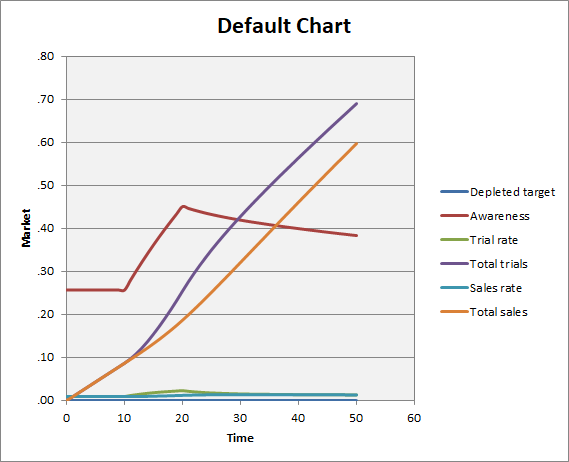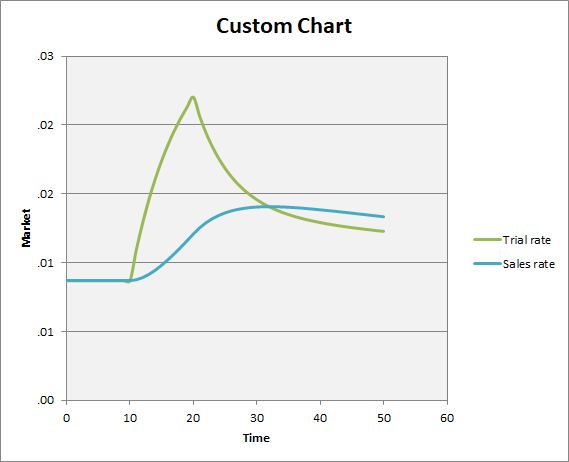Better late than never.
[ First recorded about 1200 ]
Trial and Repeat Dissipation Simulator
Microeconomics and marketing literature features three basic models of
adoption and purchase of a product on the market:
- Fourt–Woodlock
trial and repeat model
The The model is composed of a trial and a repeat parts. The trial
target segment is usually supposed to decay exponentially.
- Parfitt-Collins
steady-state model
The model is an alternative formulation of the repeating purchase by
taking in account returning customers.
- Bass
diffusion model
The adoption rate is positively influenced by the cumulative number of
adopters. Therefore, the model is sometimes called epidemic.
The three models have been united into a single model. With some
extensions, the TRD - Trial and Repeat Dissipation model was developed.
- The original models have been reformulated as stochastic by changing
the rate parameters into probabilities per time unit.
- Length of the repeat period has been added as a parameter. The length
has been set equal to the mean time of repeated purchases with
exponential dissipation (decay) of purchase probability. A user of a
product becomes a trier when the period of repeated purchase ends. The
ratio of returning users can be set as the switchback ratio.
- The model does not have an analytical solution. The numerical
Runge-Kutta integration procedure is implemented.
- A sales timeline can be composed of at most 105 time periods of
arbitrary lengths. Each time period can have different parameters
treated as constant in the time period.
- A simple tool allowing to estimate projected awareness at some
advertising intensity relative to some known intensity, has been added.
(The method comes from Arthur D. Little.)
The MS Excel-97 simulator was finalized in 2005. It appeared very soon
that the original intent to use probabilities obtained from conjoint
measurements as parameters was unrealistic. Quite generally, conjoint
derived parameters are essentially relative ones, but their absolute
values differ a lot from those on the actual market. Other required
parameters, namely mean time of the repeat cycle and switchback ratio, are
hardly obtainable from a questionnaire-based research. A consumer panel
might be of some help, but the best estimates can be obtained from
detailed market data. Such data are hardly ever revealed.
The simulator might be helpful to product managers, students of marketing
or microeconomics, and to all who are interested in studying
influence of changing market conditions on sales.
Below is a simulator produced graphics of a textbook-like example. A
little known product is subject to a well designed promotion campaign
which is leading to increase of sales.


The simulator, a description of its functionality and several examples
are available as download.
Download
TRD Simulator
 As aside
As aside
The VBA part of the simulator is protected by a
password. Please note the simulator is a historic product that has
never been or asked to be used commercially. The documentation on the
implementation is unavailable.


 As aside
As aside